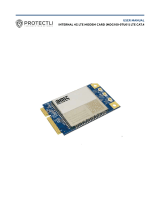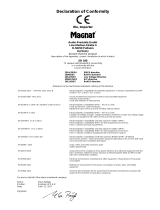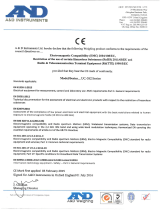Westermo MRD-405 is an industrial-grade cellular modem and router designed for demanding applications requiring reliable and secure connectivity. It supports various cellular technologies like GSM, GPRS, EDGE, HSDPA, HSUPA, HSPA, and 4G LTE, making it suitable for a wide range of applications in remote locations or moving vehicles. Additionally, its rugged design ensures durability in harsh environments.
Westermo MRD-405 is an industrial-grade cellular modem and router designed for demanding applications requiring reliable and secure connectivity. It supports various cellular technologies like GSM, GPRS, EDGE, HSDPA, HSUPA, HSPA, and 4G LTE, making it suitable for a wide range of applications in remote locations or moving vehicles. Additionally, its rugged design ensures durability in harsh environments.




















-
 1
1
-
 2
2
-
 3
3
-
 4
4
-
 5
5
-
 6
6
-
 7
7
-
 8
8
-
 9
9
-
 10
10
-
 11
11
-
 12
12
-
 13
13
-
 14
14
-
 15
15
-
 16
16
-
 17
17
-
 18
18
-
 19
19
-
 20
20
-
 21
21
-
 22
22
-
 23
23
-
 24
24
-
 25
25
-
 26
26
-
 27
27
-
 28
28
Westermo MRD-405 is an industrial-grade cellular modem and router designed for demanding applications requiring reliable and secure connectivity. It supports various cellular technologies like GSM, GPRS, EDGE, HSDPA, HSUPA, HSPA, and 4G LTE, making it suitable for a wide range of applications in remote locations or moving vehicles. Additionally, its rugged design ensures durability in harsh environments.
Ask a question and I''ll find the answer in the document
Finding information in a document is now easier with AI
Related papers
-
Westermo MRD-405 Industrial 4G LTE Router User guide
-
Westermo MRD-305-DIN User guide
-
Westermo MRD-415 User manual
-
Westermo MRD-350 User guide
-
Westermo MRD-310 User guide
-
Westermo MRD-415 User guide
-
Westermo MRD-315 Product notification
-
Westermo MRD-315 Product notification
-
Westermo BRD-355 User guide
-
Westermo Ibex-330 Series User manual
Other documents
-
Esse-ti 4GRouter User manual
-
 Protectli MDG100-0TU01 User manual
Protectli MDG100-0TU01 User manual
-
poly-planar MRD-70 Connecting Manual
-
Sencore MRD 2600 User manual
-
 Magnat Audio Sb 180 Owner's manual
Magnat Audio Sb 180 Owner's manual
-
Viola Systems M2M User manual
-
 AND UC-352 Series User manual
AND UC-352 Series User manual
-
M2M SERVICES MQ03-LTE-M-FIRE Installation guide
-
ICP M2M-720-A User manual
-
Sencore MRD 4400 User manual






























